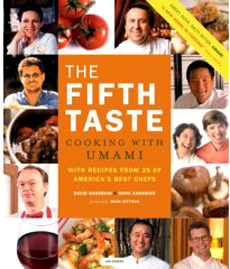

What does this classic Italian pasta dish with asparagus and Parma ham have to do with the Japanese concept of umami? Read all about it in this article, and enjoy the delicious umami recipe above for pasta with asparagus and Parma ham, recipe courtesy of the Umami Information Center.
|
KAREN HOCHMAN is Editorial Director of THE NIBBLE.
|
|
September 2006
Last Updated July 2014
|
 |
Sweet, Sour, Salty, Bitter And... Umami?
Page 1: What Is Umami? You’ve Been Eating It All Your Life!
CAPSULE REPORT: Just when you thought you understood the components of taste, you have to learn a new one—umami, the taste of brothiness or meatiness. It’s a real taste, scientifically proven. The challenge is, it’s not an easy one to learn: it requires some palate training to identify glutamate, or MSG, that is the fundamental taste of umami. This is Page 1 of a six-page article. Click on the black links below to visit other pages.
Overview: What Is Umami
In junior high school science class, we learned that humans have taste receptors for sweet, sour, salty and bitter, and the “zones” on the tongue where the receptors for these flavors were found. But while the “tongue map” of taste bud receptors has since been disproved (see the Addendum for details), a fifth taste has been added, called umami, a coined Japanese word (umai = delicious, mi = taste) that indicates a brothy or savory taste.
Umami, long understood in Asia, was the topic of one of last year’s hot cookbooks, The Fifth Taste, Cooking With Umami, by the food writer and chef duo of Anna Kasabian and David Kasabian. They not only explain what umami is, but show it in practice with an extensive collection of recipes. In fact, the alien-sounding umami flavor is everywhere familiar: in a ham and cheese sandwich and a pepperoni pizza. It’s a new word, but it’s an old taste—just like sweet, sour, bitter and salty.
There may be other official tastes to surface. The Chinese, for example, acknowledge pungent, a common taste in their cooking. Some question if certain flavor sensations are actually tastes, e.g. the heat of chile peppers, the coolness of mint and alcohol or the astringency of tannins.
|
|

The first book to explain umami to Westerners—with 50 recipes that translate words into tastes. Get a copy. |
These discussions are not intellectual debates but can be scientifically measured, so we’ll hear more about them in the future. But for today, let’s figure out umami.
The Umami Information Center has a website with much more extensive information and a newsletter for interested students of umami. To them we are grateful for the recipes and for much of the lovely photography in this article.
Continue To Page 2: Our Umami Heritage
Go To The Article Index Above

|